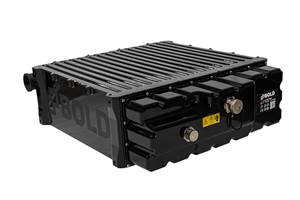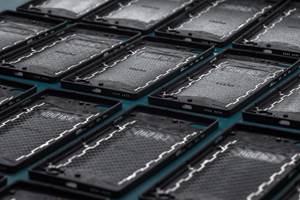Continuous fiber TPCs are smart for world’s largest appliance manufacturer
Unveiled on March 8 at the China Household Electrical Appliances and Consumer Electronics Fair (AWE, Shangai), Haier’s (Qingdao, China) “smart” Tianxi air conditioner is the world’s first AC unit to feature continuous fiber reinforced thermoplastic (CFRTP) materials. in its high-end Casarte line (Italian “Casa” for home and “Arte” for art), The relationship holds much promise for CFRTP supplier Covestro (Leverkeusen, Germany; Pittsburgh, PA, US; Shanghai, China). The world’s number one appliance manufacturer, Haier’s products can alread be found in 1 million households.
Unveiled on March 8 at the China Household Electrical Appliances and Consumer Electronics Fair (AWE, Shangai), Haier’s (Qingdao, China) “smart” Tianxi air conditioner is the world’s first AC unit to feature continuous fiber reinforced thermoplastic (CFRTP) materials.
in its high-end Casarte line (Italian “Casa” for home and “Arte” for art), The relationship holds much promise for CFRTP supplier Covestro (Leverkeusen, Germany; Pittsburgh, PA, US; Shanghai, China). The world’s number one appliance manufacturer, Haier’s products can alread be found in 1 million households. The Tianxi conditioner is part of Haier’s Casarte product line, which also include refrigerators, washing machines, water heaters and many other appliances. “Smart” air conditioners, however, are a high-growth, strategic market. The Casarte Tianxi stands at 1.8 m tall and uses CFRTP in the air conditioner’s twin cylinder housing. Developed in partnership with Covestro. The composite material combines unidirectional glass or carbon fiber with polycarbonate (PC) thermoplastic resin in thin tapes. These are cut and stacked to form tailored laminates and then thermoformed with existing tools at high yield rates and short cycle times, according to Michael Schmidt, co-CEO, with David Hartmann, of Covestro CFRTP.
“Up until now, we have been quite limited in terms of material selection, typically relying on metal to provide the performance and aesthetics that we require,” says Shao Qingru, one of the color, material, finish (CMF) designers in Haier’s Casarte design team. “CFRTP is a very attractive material for us in that it has a natural, unidirectional surface pattern right from the start, unlike metals such as aluminum that requires some combination of finishing processes, like sandblasting, brushing and anodizing, before it is ready to go into the product. For CFRTP, the finish is all natural and has a beauty to itself.”
Covestro material scientist Yilan Li, who helped to develop CFRTP for use in the Tianxi unit, explains the material’s appeal: “Unlike metal, CFRTP is light; unlike plastics, it’s stiff; and unlike thermosets, it’s fast [in cycle times].” She adds that the material is easy to form, offers design flexibility and has high temperature and impact resistance as well as good strength properties.
The Casarte Tianxi housing is molded by Suzhou Yichangtai Plastic Co., Ltd, which has been in the plastics processing industry for over two decades. “I see huge potential from unidirectional carbon fiber composites,” says Suzhou Yichangati general manager Chen Jinming. “UD allows designers and engineers the basic ability to tune the material to perform differently based on fiber orientation. As a thermoplastic material, it shortens cycle times and reduces costs compared to thermosets. I think the time for thermoplastics has come. Whoever invests in the technologies now will have a competitive advantage in the future.”
Again, the supply chain is being engineered to perform, led by the materials supplier with key partners. Covestro and Haier signed a global strategic agreement in Oct 2017 to expand their partnership to a global scale, aiming to continuously develop advanced products featuring the latest materials to address the demands of the global home appliances market. “As a raw material supplier, we don’t just sell our materials and sit back and watch,” says Covestro’s Yilan. “To bring a new class of material to the market, we need to get the value chain to adopt it. If the value chain is not there, we build it.”Related Content
Exel secures design patent extension for pultruded fiberglass radomes
Technique for antenna radomes forms “functional zones” inside composite material, enhancing existing 5G technology performance, application potential.
Read MoreAviation-specific battery system uses advanced composites to address electric, hybrid flight
BOLDair’s composite enclosure, compression structures and thermal runaway management enables high-performance electric energy storage.
Read MoreCarbon Mobile carbon fiber powers handheld gaming platform
HyRECM technology effectively stabilizes carbon fiber’s electrical and antenna properties, enabling development of next-gen electronics, such as the Snapdragon G3x Gen 2.
Read MoreCarbon Mobile, SABIC to develop, deploy advanced carbon fiber in connected devices
Collaboration aims to deliver the next generation of thinner, lighter, stronger and more sustainable composite materials used in consumer electronics and automotive industries.
Read MoreRead Next
VIDEO: High-volume processing for fiberglass components
Cannon Ergos, a company specializing in high-ton presses and equipment for composites fabrication and plastics processing, displayed automotive and industrial components at CAMX 2024.
Read MoreDeveloping bonded composite repair for ships, offshore units
Bureau Veritas and industry partners issue guidelines and pave the way for certification via StrengthBond Offshore project.
Read More“Structured air” TPS safeguards composite structures
Powered by an 85% air/15% pure polyimide aerogel, Blueshift’s novel material system protects structures during transient thermal events from -200°C to beyond 2400°C for rockets, battery boxes and more.
Read More









.jpg;maxWidth=300;quality=90)














